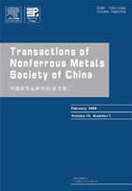Preparation, electrochemical properties and energy storage mechanism of vanadium-based Prussian blue analogues as cathode materials for aqueous ammonium ion batteries
(1. School of Materials Science and Engineering, Northeastern University, Shenyang 110819, China;
2. Shandong Provincial Key Laboratory of Chemical Energy Storage and Novel Cell Technology, College of Chemistry and Chemical Engineering, Liaocheng University, Liaocheng 252059, China;
3. Key Laboratory of Dielectric and Electrolyte Functional Materials of Hebei Province, School of Resources and Materials, Northeastern University at Qinhuangdao, Qinhuangdao 066004, China)
2. Shandong Provincial Key Laboratory of Chemical Energy Storage and Novel Cell Technology, College of Chemistry and Chemical Engineering, Liaocheng University, Liaocheng 252059, China;
3. Key Laboratory of Dielectric and Electrolyte Functional Materials of Hebei Province, School of Resources and Materials, Northeastern University at Qinhuangdao, Qinhuangdao 066004, China)
Abstract: To explore high-performance cathode materials for aqueous ammonium ion batteries (AAIBs), vanadium- based Prussian blue analogue composites (VFe-PBAs) were prepared by hydrothermal coprecipitation method to enhance the reversible storage of NH4+. Benefiting from the stable three-dimensional structure and spacious gap position, VFe-PBAs-2 cathode displays excellent electrochemical activity and rate performance, achieving a high specific capacity of 84.3 mA·h/g at a current density of 1000 mA/g. In addition, VFe-PBAs-2 cathode also shows impressive long-term cycle durability with 85.2% capacity retention after 3×104 cycles at 5000 mA/g. The synthesized cathode materials combined with the high electrochemical activity of vanadium ions significantly promote the rapid transfer of NH4+. Furthermore, NH4+ embedding/extraction mechanism of VFe-PBAs-2 cathode was revealed by electrochemical kinetics tests and advanced ex-situ characterizations. The experimental results demonstrate that vanadium-modified VFe-PBAs-2 as a cathode material can remarkably improve the capacity, electrochemical activity and cycling stability of AAIBs to achieve high performance NH4+ storage.
Key words: energy storage; aqueous ammonium ion battery; Prussian blue analogues; rate performance; cycling stability

